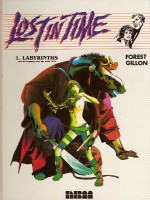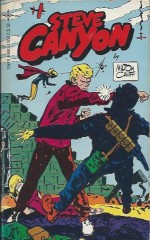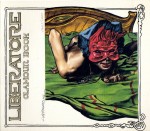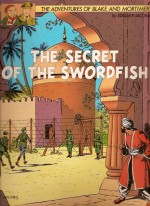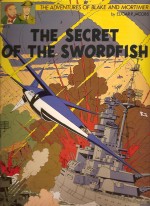
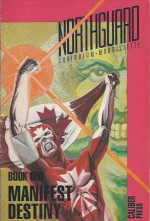
By Mark Shainblum & Gabriel Morrissette with Jacques Boivin and others (Caliber Press)
No ISBN, ASIN B00071Y8KK
The huge outpouring of fresh material which derived from the birth of American comicbooks’ Direct Sales revolution produced a plethora of innovative titles and creators – and let’s be honest – a host of appalling, derivative, knocked-off, banged-out trash too.
Happily I’m the boss of me and I choose to focus on the good and even great stuff…
The 1980s were an immensely fertile time for English-language comics-creators. In America an entire new industry had started with the birth of dedicated comics shops and, as innovation-starved specialist retail outlets sprung up all over the country, operated by fans for fans, a host of new publishers began to experiment with format, genre and content, whilst eager readers celebrated the happy coincidence that everybody seemed to have a bit of extra cash to play with.
Consequently those new publishers were soon aggressively competing for the attention and cash of punters who had grown resigned to getting their sequential art jollies from DC, Marvel, Archie and/or Harvey Comics. European and Japanese material began creeping in and by 1983 a host of young companies such as WaRP Graphics, Pacific, Eclipse, Capital, Now, Comico, Dark Horse, First and many others had established themselves and were making impressive inroads.
Most importantly, by avoiding the traditional family-focussed sales points such as newsstands, more mature material could be produced: not just increasingly violent and sexually explicit but also far more political and intellectually challenging too.
Subsequently, much of the “kid’s stuff†stigma finally dissipated andAmericabegan catching up to the rest of the world, partially acknowledging that comics might be a for-real art-form.
New talent, established stars and different takes on the old forms all found a thriving forum desperate for something a little different. Even smaller companies and foreign outfits had a fair shot at the big time and a lot of great material came – and, almost universally, as quickly went – without getting the attention or success they warranted.
One of the most critically acclaimed and enthralling features was a bleak yet fearfully authentic-seeming interpretation of real-world superheroics from Canadian independents Matrix Books who launched another superb and too-soon-lost costumed crusader on an uncaring world in 1984 with the advent of New Triumph featuring Northguard #1-5. The black and white series for mature readers was sadly lost in a growing storm of black and white self-published titles of varying quality and folded in 1985.
In 1989, Caliber Press licensed the property and launched a general readership, 3-issue miniseries Northguard: the ManDes Conclusion to wrap up the interrupted storyline, simultaneously packaging the original Matrix issues as Northguard: Manifest Destiny, one of the industry’s earliest trade paperback collections.
Written by Matrix founder Mark Shainblum and illustrated by Gabriel Morrissette the story is one that will delight dyed-in-the-wool comics fans as one of their own finally lives the dream…
The volume begins with a fascinating potted history of Canada’s comics industry and love-affair with patriotic superheroes in John Bell’s Foreword after which ‘…And Stand on Guard…’ (lettered by Ian Carr and with an early plotting and art assistance credit for Geof Isherwood) opens with a grisly assassination and a tragic air disaster, before introducing young Phillip Wise ofMontreal.
Left at home whilst his parents vacationed, the young fanboy is just settling in with a stack of comicbooks when a knock at the door leads to his abrupt abduction…
Regaining consciousness in a palatial apartment, Phillip is introduced to billionaire inventor Ron Cape, a single-minded, altruistic industrialist who runs P.A.C.T. – Progressive Allied Canadian Technologies – a company run by benevolent capitalists with a new world vision…
Capehas his own spy team “Unit 7â€, used to protect company secrets and keep his rivals honest, but in the course of their investigations the team has obtained proof that an American company is planning to overthrow the Canadian government. Their only clue to the scheme is the enigmatic code-term “ManDesâ€â€¦
Used to direct action, P.A.C.T. intended to use a uniquely gifted, trained operative and their latest prototype – a miraculous energy weapon dubbed the Uniband – to covertly counter the imminent threat, but that guy was just murdered and his deputy died in an air crash. Now the device needs months of calibration to a specific set of brainwaves before it can be used…
Without a new controller the Uniband, which taps into a whole, new set of physics, is just a very expensive piece of ugly jewellery, but after hacking all the medical records in Quebec, the P.A.C.T. team luckily found a near-match for their dead agent’s thought patterns…
As the awestruck kid ponders the offer of a lifetime, in America’s Deep South a Fundamentalist Christian and racist manic named Tyler who runs Ultra, one of the world’s most powerful corporations, takes further steps to thwart Cape and his inner circle…
After a pensive night Phillip reaches a decision. He will become P.A.C.T.’s human gun, but only on his own terms. Rather than a secret agent Wise wants the technologists to turn him into a real-life superhero – complete with mask and costume…
Over a barrel and against the advice of his subordinates and directors, Capecomplies and Phillip rapidly undergoes cybernetic surgery and radical physical training to enable him to use the miraculous Uniband. No one is aware that the boy is already a target of Dugan, the assassin who killed his predecessor.
In a bloody confrontation however, the barely-competent kid turns the tables on his coldly pragmatic attacker by thinking like a comic book character and not a rational, trained professional…
Northguard, as Phillip now calls himself, even manages to very publicly save the Premier of the province on live TV and foil the ManDes scheme to instigate an Anglo-French race war inQuebec…
‘Awaken the Dreamers’ (with Bernie Mireault helping out Morrissette on the art) finds the Jewish Phillip tormented by nightmares of racial atrocity and P.A.C.T.’s core team riven by doubt and dissent at the turn events have taken. Nobody signed on to become clandestine policemen and the consequent death toll has everybody rattled…
Meanwhile in the basement of their HQ, Dugan has broken out of custody and gone on a murderous rampage through the building. This time though, he’s ready for the kid with the wonder-weapon and easily defeats him, but then makes the horrific mistake of trying to use Uniband himself…
Frustrated by his constant failures “The Reverend†prays for guidance and hears the Word of God. Ultra has two years to wipe out the blasphemy that isCanadaor the Almighty will cleanse the entire Earth…
Inked by Jacques Boivin, ‘Target Red, Target Blue: Making Hate’ finds Phillip called to P.A.C.T. to be stripped of the Uniband he failed to protect, but absconding before they can remove it. Wandering the streets of Montreal, he finds himself at a dojo and watches a stunning display of martial arts grace and power. With thoughts of learning taekwon-do he chats with the devastating Manon DesChamps and before he even knows what he’s doing the lad has transformed into Northguard before her unbelieving, admiring eyes…
Meanwhile in Boston, Massachusetts, Vietnamvet Ed Holman gets a package from P.A.C.T. that will make his new job even easier. The corporation’s latest technological marvel, acting with the metal plate in his head, now enables him to change his appearance at the press of a button. The Steel Chameleon is ready to become P.A.C.T.’s only super-agent…
As Manon attempts to teach Northguard to fight, they are attacked by a mercilessly efficient squad of operatives led by a psychotic American woman named Valerie White and only Phillip’s overwhelming firepower and Manon’s skill allow them to escape alive…
‘Target Red, Target Blue: Never Surrender’ (with additional inking from J. Harpes & friends) finds Steel Chameleon being briefed by Cape as Phillip awakens at Manon’s apartment. Almost immediately a Russian operative codenamed Redstorm warns the youngsters that Valerie has tracked them down and offers to buy the Uniband for an astronomical sum…
Whilst Holman reviews Intel and realises Valerie – a ruthless USagent known as Eagle – and Redstorm are about to renew their mutually assured and long-running dance of sex and death on Canadian soil, his phone rings. Once again Phillip has done the unexpected in a crisis and simply called for help.
But even as Steel Chameleon rushes to their location, Northguard and Manon have moved to direct action, blasting the Soviet team’s car as a distraction before fleeing on a motorcycle. With Eagle and her squad in hot pursuit the young fugitives are trapped in a shopping mall by the relentless Cold Warriors as keen to kill each other as take the Uniband…
With bullets flying and bodies dropping everywhere Holman arrives just in time to push the rival agents into a horrific miscalculation…
And at Ultra, the Reverend rages at another scheme spoiled by the infernal P.A.C.T. unbelievers and decides to declare all-out economic war onCape’s company…
This terrific tome sadly stops – but doesn’t end – on a compelling low note with ‘Games of the Heart’ as the assorted cast-members are shown in poignant and telling vignettes. Reverend Tyler lays his divinely-inspired plans and marshals his religious zealots whilst the troubleCape loses his most trusted and intimate confidante and Phillip reels with unaccustomed jealousy after meeting Manon’s boyfriend.
The determined kid still holds it together enough to undergo his first explosive full training session under the supervision of Steel Chameleon, however…
Of course nobody expected Manon to show up in a costume of her own, so how could they expect the dazzling Fleur-de-Lys to be so exceptionally efficient and effective at the whole superhero thing…
© 1984, 1985, 1986 and 1989 Mark Shainbloom and Gabriel Morrisette. Northguard, Fleur-de-Lys and all prominent characters are ™ Mark Shainbloom and Gabriel Morrisette. All rights reserved. Steel Chameleon © 1989 and ™Richard Comely/Star Rider Productions. Used under license.


